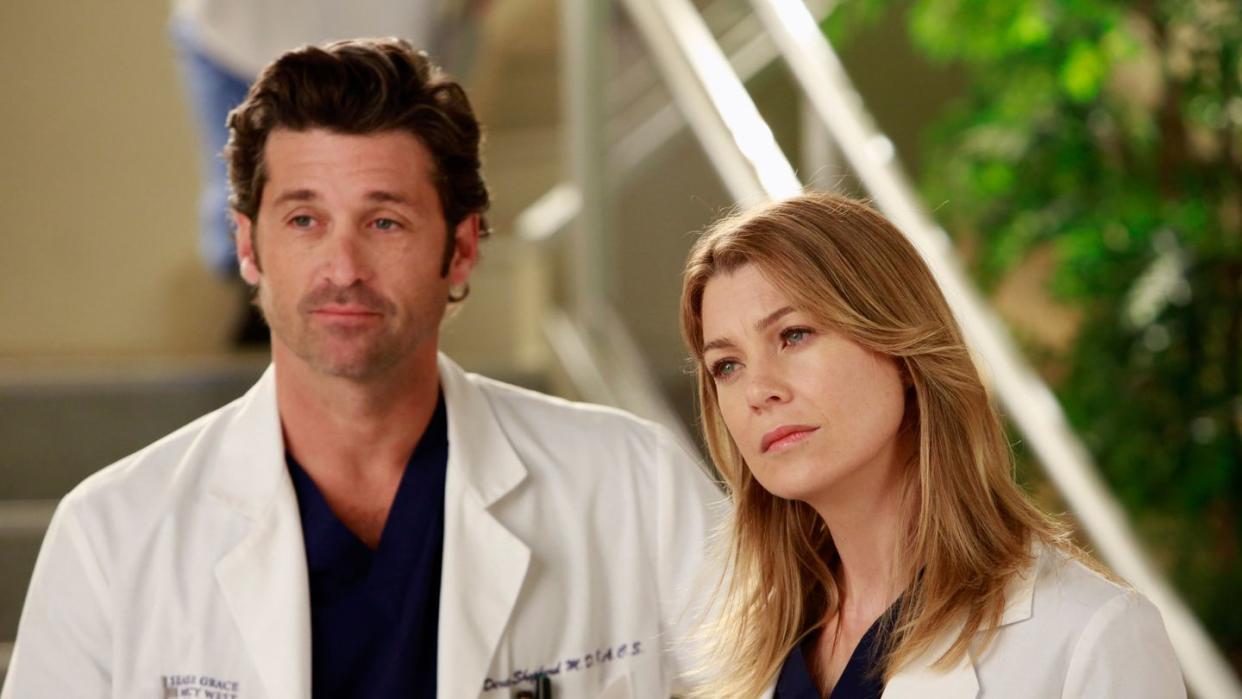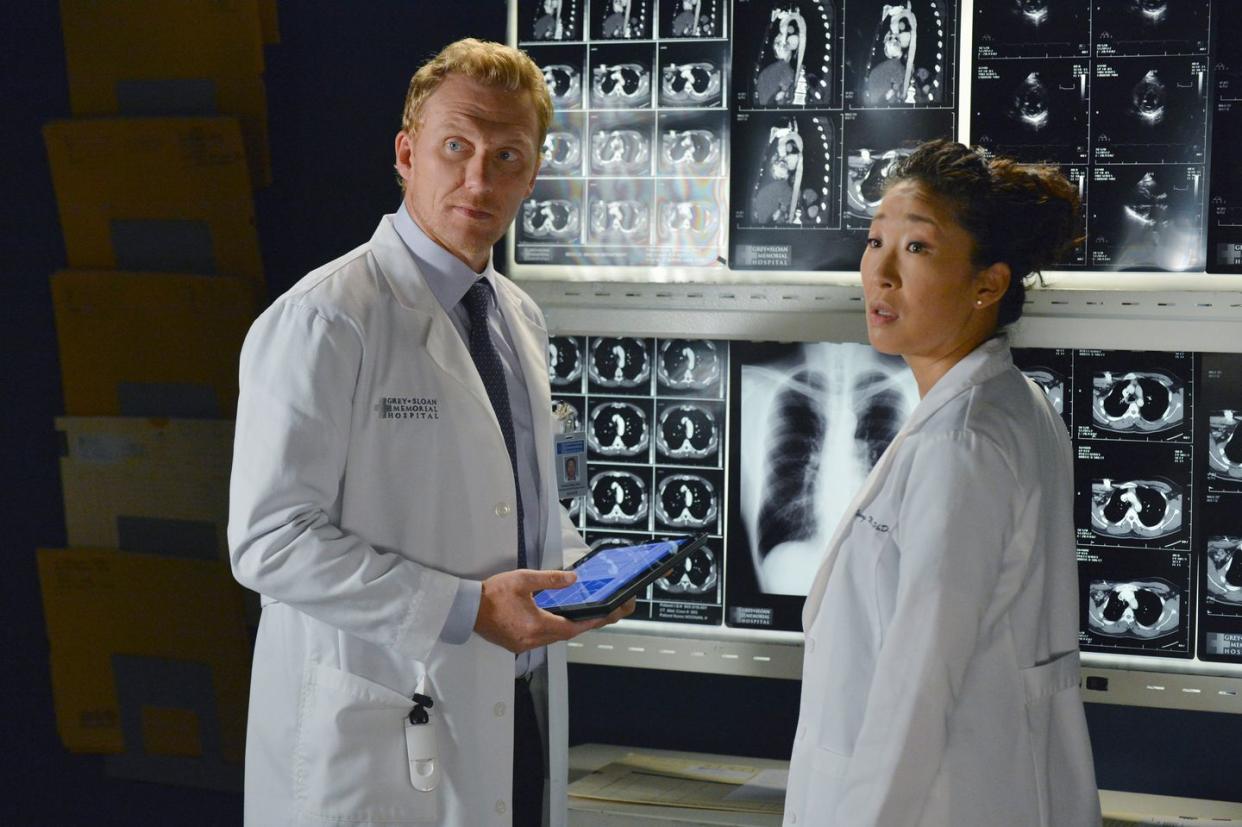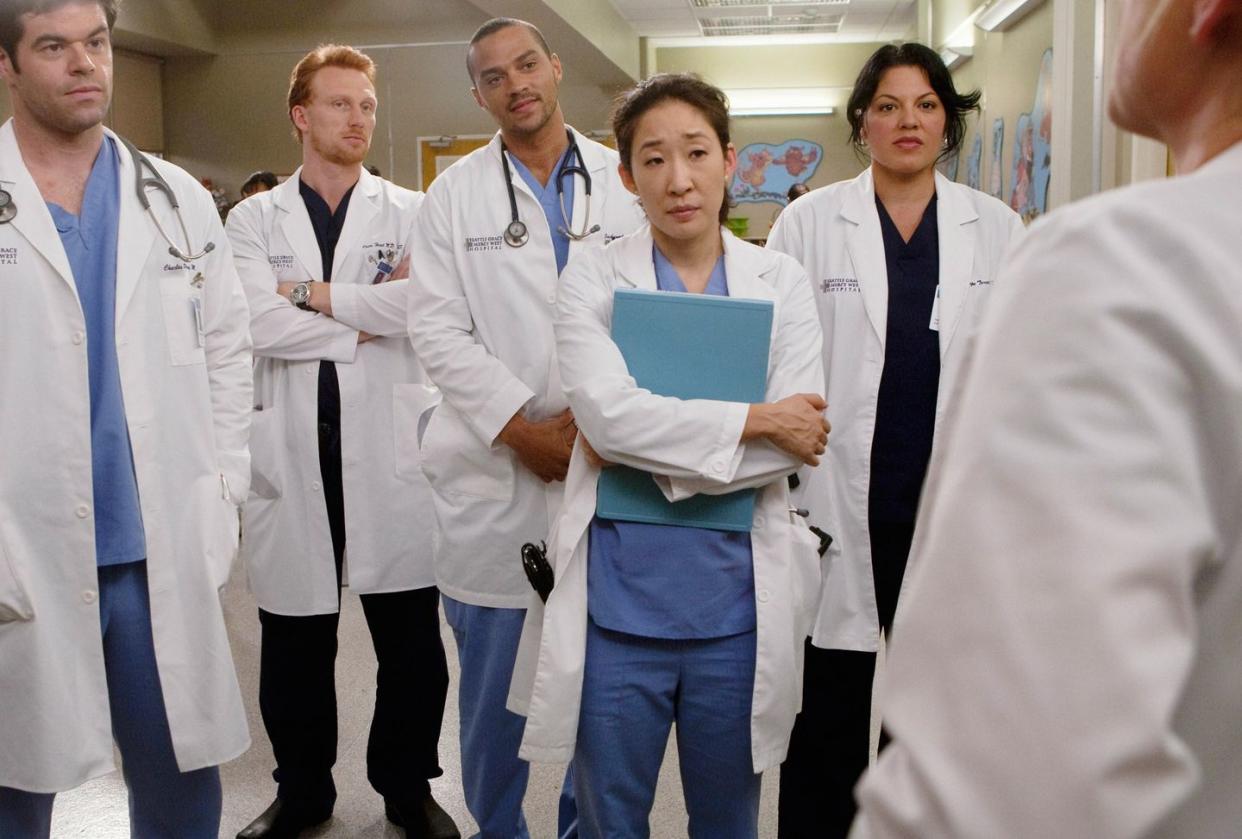How “Grey’s Anatomy” Became the Ultimate Coping Mechanism

"Hearst Magazines and Yahoo may earn commission or revenue on some items through these links."
It wasn’t until I’d spent the night in the hospital for the first time that I got sucked into one of the greatest medical dramas of all time.
It was a couple of years ago. One moment I was on the couch, relaxing after a hot bath. The next, I was in the worst pain I’d ever experienced, being syringed full of morphine and lifted into an ambulance. Five days later, after a lot of tests and more drugs, I was back home in bed recovering in a bedroom that, thanks to my friends and family, now resembled a florist shop.
Feeling a little sorry for myself as I recovered from a nasty kidney infection, I decided I needed a new show to focus on. This is where my obsession with Grey’s Anatomy began. In a few short months, I watched the first 18 seasons of the ABC hospital drama—the brainchild of TV creator Shonda Rhimes—which premiered in 2005. (The first of many hits for Rhimes, it would be followed by spin-off Private Practice, Scandal, How to Get Away With Murder, and Bridgerton.) That’s roughly 350 episodes, which equates to around 11 days of total viewing time.
The 20th season of Grey’s Anatomy premieres this week. I’ve often wondered why I watched this show faster and more intensely than any other. At its core, Grey’s is a show all about trauma—more precisely, viewers dealing with our own trauma via the professional and personal turmoil endured by the series’ unbelievably hot fictional doctors. As played by the likes of Sandra Oh, Patrick Dempsey, and Katherine Heigl, the medical professionals of Grey’s all have perfect hair and plenty of baggage. Looking back at it, a therapist would probably have a field day with my decision to watch a show all about surgeons and death right after my first hospital stay, when my body was at its weakest and my mind had been altered by the shock of experiencing so much pain so suddenly.
As I plowed through almost two decades of the characters’ trauma, the hospital’s longest-serving doctors—Meredith Grey (Ellen Pompeo), Miranda Bailey (Chandra Wilson), and Richard Webber (James Pickens Jr.)—began to feel like an extended family. One whose members had been gradually picked off by plane crashes, Alzheimer’s, cancer, addiction, car crashes, brain tumors, mass shootings, and many other causes of death, sometimes as bizarre as they were tragic.
I’m not the only person who has used Grey’s—and the lead character of Meredith Grey, specifically—as a crutch in a time of trauma. The longevity and ceaseless tragedy of Meredith’s run on the show make her one of TV’s greatest survivors and gay icons, who inspired countless real-life doctors to pursue careers in medicine. Taylor Swift—head of the Tortured Poets Department, no less—has a cat named after Meredith, and Pompeo has said that, for the last 20 years, people all over the world have told her how her character’s resilience has helped them.

Like me, writer Emily Gould watched all the available seasons of Grey’s in one go. Meredith became her emotional rock throughout a period of chronic depression. “It gets to the morbid point where you almost hope that something challenging happens to Meredith, just so we get that cathartic moment of watching her survive it,” Gould explains. “If Meredith can still go to work with her hair looking good and clearly wearing some lip gloss—after what she’s been through—then I can brush my teeth and take a shower today.”
The show’s allure is also grounded in its satisfying narrative structure. Each episode is introduced by an opening narration by Meredith. Over the next hour, we see a mixture of personal storylines interwoven involving the hospital’s patients, which all converge by the end, when another monologue by Meredith links them all together. The final remarks are loosely connected to whatever Meredith said at the beginning, and usually made as a slow, melancholic song by Coldplay, the Fray, OneRepublic, or another band composed of identical-looking white guys with slightly different beards plays under them.
The combination of intro and outro narration reminds me of other shows I continually turn to in times of crisis: Sex and the City and Desperate Housewives. There is something so comforting about the formula of two statements linked together by a handful of storylines, neatly coming together at the end of an episode. It helps us project ourselves into the characters’ stories, while remaining spectators who are unaffected by them. And the formula also lets us, as viewers, cede a certain level of responsibility. Usually, we would be the sole presence watching over the characters. The narrator takes some of that stress away from us. Writing about Desperate Housewives narrator Mary Alice Young (voiced and played by Brenda Strong), Marianne Eloise notes that she “ties it all together with the all-seeing judgmental tone that only she possesses.” The moment she dies by suicide in the pilot episode, Mary Alice becomes “both omnipresent and omniscient; flitting about in the air above Wisteria Lane, predicting the next affair, murder, stolen child or scandal on the street she once loved.”
Grey’s is also a story about how much the expectations on mainstream TV shows have changed over the last two decades, both in terms of content and representation. From the beginning, the show’s cast was racially diverse—a feature in common with other Rhimes creations like Bridgerton or How to Get Away With Murder. Still, in the early seasons, the show rarely discussed race. Sandra Oh later described her frustration at what she said was a deliberate choice not to mention race for the first 10 seasons. Rival hospital drama ER—which revolved around a Chicago hospital emergency department—felt more political compared to the fancy folks at (the since-renamed) Seattle Grace.
Gradually, Grey’s began to introduce storylines that were more overtly political, covering topics from abortion rights and gun control to police brutality. Systemic racism, particularly in medicine, is now a recurring theme. The show has become more LGBTQ+ inclusive, too, with multiple queer characters—including the first nonbinary character, Dr. Kai Bartley (E.R. Fightmaster). The most recent season had a central focus on the repeal of Roe v. Wade, with Private Practice protagonist Dr. Addison Montgomery (Kate Walsh) returning on a quest to bring reproductive healthcare to women who were being denied access to it. In a particularly harrowing episode, a patient had traveled out of state for an abortion after her pregnancy put her life at risk. She bled out in the back of an ambulance as Addison desperately tried to save her. “I had never seen anything like that on a traditional network show. Or even on a streaming service,” Gould says, remembering the November 2022 episode. “It really made me think, ‘Go, Grey’s.’ ”

My first stay in a hospital was a far cry from Seattle’s pioneering surgery department, where everyone seems to have perfect abs. But my defining memory of the weeks after was an awareness of my own body and its fallibility. As a naive 28-year-old, I had never before truly realized that we are all just bodies made up of organs and other parts that, at any moment, could let us down. Buried deep in a show all about death and trauma, I was fortunate to make a full recovery. But it made me wonder: Why are we so comfortable watching people die on TV and in films, sometimes endlessly, yet still so bad at talking about death in our real lives?
At the point I’m describing, I felt completely surrounded by death. The U.K., where I live, was still under lockdown because of Covid. Everything felt scary and unknown. For me, as for many others, immersing myself in the drama of Grey Sloan Memorial hospital served as a coping mechanism as images of desperate conditions from real hospitals filled up my social feeds. When most restrictions were lifted in summer 2021, a new season of Grey’s arrived in the U.K. soon after, centered on the hospital’s response to the virus. Meredith entered a coma, and was reunited in a vision with her deceased husband, Derek, and sister Lexie, on a sunny beach. For the first time, I found myself momentarily pulling away from the show. Watching traumas that were often dramatic, ridiculous, and removed from my life was a very different experience from watching a dramatized version of something we’d all collectively lived through months prior. The trauma was a little too real, suggesting to me that we demand a heavy dosage of fantasy from Grey’s. “We go to the show for escapism and to watch doctors having sex in hospital closets,” Gould says. “When they’re not having sex in the closets, the show can lose some of its momentum.”
Speaking of momentum, the upcoming 20th season of Grey’s marks a major change. Meredith will no longer be appearing as a lead—although she will continue her iconic narration from a distance, channeling Mary Alice Young. Shonda Rhimes once said herself that there “would be no Grey’s without Meredith Grey,” but that’s exactly how the show plans to go on—with a crop of new interns and the reintroduction of old faces, including Dr. Arizona Robbins (Jessica Capshaw).
That everlasting, never-ending nature of Grey’s is the show’s greatest strength—that feeling of security that comes from knowing you can sit down and watch it and know it’ll last for as long as you need it to. Soap operas have a similar quality; the show’s lore and its web of returning characters feel almost infinite in scope. “Grey’s has done a great job of making itself endlessly reproducible,” Gould says. “I personally hope that it runs until I die.” Maybe in 50 years, we’ll be watching an AI Ellen Pompeo playing Meredith Grey after the actor sells her likeness to ABC for all eternity? Maybe Meredith’s brain will have been miraculously transplanted into someone else’s body, making her functionally immortal? Maybe her oldest child, Zola, will become chief of surgery at Seattle Grace Mercy West Grey Sloan Webber Addison Bailey Memorial Hospital?
For coming up on 20 seasons, Grey’s Anatomy has been a comfort blanket to its fans in our hour of need. The show constantly reminds us, often brutally and always dramatically, of the most difficult truth: Life doesn’t last forever. Nothing does. Except maybe this show should, because how would we cope without it?
You Might Also Like
